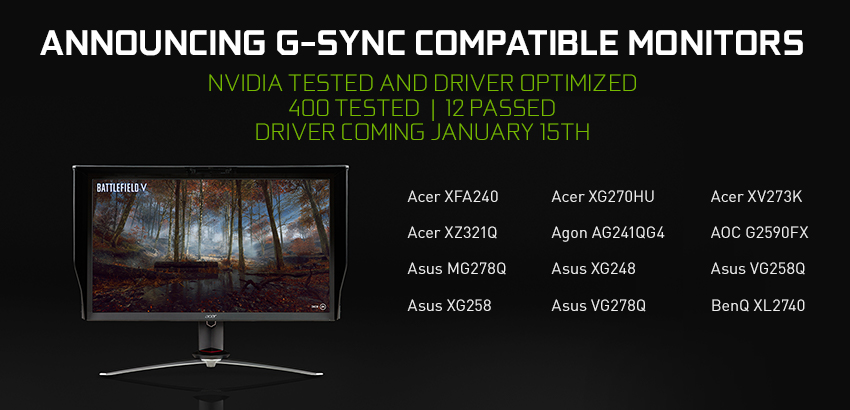As a bit of a win for everyone, NVIDIA have announced that they will be supporting VESA Adaptive Sync.
While NVIDIA have been pushing their own proprietary G-SYNC to get rid of screen tearing, AMD has been pushing the more open FreeSync. Annoying as always, since it splits the market for us consumers and makes things more difficult for us.
Announced a few hours ago, NVIDIA will be supporting some FreeSync monitors with their own special branding. They claim there's a huge difference in how well some monitors work and so they will be testing various monitors and approving them.
To start with, they will support these monitors:
However, it's not totally down to NVIDIA on what monitors will work. They will be including an option in the NVIDIA control panel for you to try yourself:
For VRR monitors yet to be validated as G-SYNC Compatible, a new NVIDIA Control Panel option will enable owners to try and switch the tech on - it may work, it may work partly, or it may not work at all.
Additionally, it seems they will only be supporting this across GeForce GTX 10-Series and GeForce RTX 20-Series graphics cards so my lowly 980ti is out of luck.
They say a new driver will be out later this month, although it's not entirely clear what the status of Linux support will be. Hopefully there won't be any issues, since as far as I can tell G-SYNC is supported on Linux already.
See more on the official NVIDIA post.
- 27-32 inch panel
- IPS quantum dot LED display
- Freesync
- ≤4 ms response time
- ≥1440p resolution
- 75 Hz refresh rate
- ≤$250 price tag
I may be in for a long wait.
From all I've seen, G-Sync works fine on both monitors, though I never got the 'gsync indicator' to work, it's been there long before the 4xx drivers though, contrary to the other person that said that.Are you sure it works? What does the Graphics API Indicator say? I said it appeared in 4xx because a friend of mine tested 396.54 (IIRC) and there were no indicator options at all in nvidia-settings, and that's the last 3xx branch version.
The G-Sync indicator appears in the top right corner, it's a green label that says "G-SYNC" in a thin ugly (for my taste) font, nothing fancy like in the Windows driver. If it's not there (and the option in nvidia-settings is on) you probably don't have G-Sync enabled and only have the regular V-Sync.
TLDR: Multi-monitor G-Sync in Linux sucks goat nads. My next card will be AMD. Period.Is Freesync better in this regard? I thought it's a display hardware or Xorg's limitation as it's all the same on Windows. But I haven't researched that.
Like I've said, I've clicked on the check mark for the indicator but nothing happens. It does in Windows, but it also has an option for Full screen, or Full screen and Windowed.
What I have been going by is that it actually says the monitor is in G-Sync Mode when I click on the settings. Otherwise it just says 144hz.
Now I do have in my .nvidia-settings-rc file this; but again, doesn't seem to allow the indicator to work.
#
# /home/$USER/.nvidia-settings-rc
#
# Configuration file for nvidia-settings - the NVIDIA X Server Settings utility
# Generated on Mon Jan 7 19:12:17 2019
#
# ConfigProperties:
RcFileLocale = C
DisplayStatusBar = Yes
SliderTextEntries = Yes
IncludeDisplayNameInConfigFile = Yes
ShowQuitDialog = Yes
UpdateRulesOnProfileNameChange = Yes
Timer = PowerMizer_Monitor_(GPU_0),Yes,1000
Timer = Thermal_Monitor_(GPU_0),Yes,1000
Timer = Memory_Used_(GPU_0),Yes,3000
Timer = Memory_Used_(GPU_1),Yes,3000
Timer = Thermal_Monitor_(GPU_1),Yes,1000
Timer = PowerMizer_Monitor_(GPU_1),Yes,1000
# Attributes:
skint:1.0/SyncToVBlank=1
skint:1.0/LogAniso=0
skint:1.0/FSAA=0
skint:1.0/TextureClamping=1
skint:1.0/FXAA=0
skint:1.0/AllowFlipping=1
skint:1.0/FSAAAppControlled=1
skint:1.0/LogAnisoAppControlled=1
skint:1.0/OpenGLImageSettings=1
skint:1.0/FSAAAppEnhanced=0
skint:1.0/AllowGSYNC=0
skint:1.0/ShowGSYNCVisualIndicator=1
skint:1.0/ShowGraphicsVisualIndicator=1
skint:1[DPY:DP-0]/Dithering=0
skint:1[DPY:DP-0]/DitheringMode=0
skint:1[DPY:DP-0]/DitheringDepth=0
skint:1[DPY:DP-0]/ColorSpace=0
skint:1[DPY:DP-0]/ColorRange=0
skint:1[DPY:DP-0]/SynchronousPaletteUpdates=0
skint:1[DPY:DP-1]/Dithering=0
skint:1[DPY:DP-1]/DitheringMode=0
skint:1[DPY:DP-1]/DitheringDepth=0
skint:1[DPY:DP-1]/ColorSpace=0
skint:1[DPY:DP-1]/ColorRange=0
skint:1[DPY:DP-1]/SynchronousPaletteUpdates=0
skint:1[DPY:HDMI-0]/Dithering=0
skint:1[DPY:HDMI-0]/DitheringMode=0
skint:1[DPY:HDMI-0]/DitheringDepth=0
skint:1[DPY:HDMI-0]/ColorSpace=0
skint:1[DPY:HDMI-0]/ColorRange=0
skint:1[DPY:HDMI-0]/SynchronousPaletteUpdates=0
skint:1[DPY:DP-2]/RedBrightness=0.000000
skint:1[DPY:DP-2]/GreenBrightness=0.000000
skint:1[DPY:DP-2]/BlueBrightness=0.000000
skint:1[DPY:DP-2]/RedContrast=0.000000
skint:1[DPY:DP-2]/GreenContrast=0.000000
skint:1[DPY:DP-2]/BlueContrast=0.000000
skint:1[DPY:DP-2]/RedGamma=1.000000
skint:1[DPY:DP-2]/GreenGamma=1.000000
skint:1[DPY:DP-2]/BlueGamma=1.000000
skint:1[DPY:DP-2]/Dithering=0
skint:1[DPY:DP-2]/DitheringMode=0
skint:1[DPY:DP-2]/DitheringDepth=0
skint:1[DPY:DP-2]/ColorSpace=0
skint:1[DPY:DP-2]/ColorRange=0
skint:1[DPY:DP-2]/SynchronousPaletteUpdates=0
skint:1[DPY:DP-3]/Dithering=0
skint:1[DPY:DP-3]/DitheringMode=0
skint:1[DPY:DP-3]/DitheringDepth=0
skint:1[DPY:DP-3]/ColorSpace=0
skint:1[DPY:DP-3]/ColorRange=0
skint:1[DPY:DP-3]/SynchronousPaletteUpdates=0
skint:1[DPY:DP-4]/RedBrightness=0.000000
skint:1[DPY:DP-4]/GreenBrightness=0.000000
skint:1[DPY:DP-4]/BlueBrightness=0.000000
skint:1[DPY:DP-4]/RedContrast=0.000000
skint:1[DPY:DP-4]/GreenContrast=0.000000
skint:1[DPY:DP-4]/BlueContrast=0.000000
skint:1[DPY:DP-4]/RedGamma=1.000000
skint:1[DPY:DP-4]/GreenGamma=1.000000
skint:1[DPY:DP-4]/BlueGamma=1.000000
skint:1[DPY:DP-4]/Dithering=0
skint:1[DPY:DP-4]/DitheringMode=0
skint:1[DPY:DP-4]/DitheringDepth=0
skint:1[DPY:DP-4]/ColorSpace=0
skint:1[DPY:DP-4]/ColorRange=0
skint:1[DPY:DP-4]/SynchronousPaletteUpdates=0
skint:1[DPY:DP-5]/Dithering=0
skint:1[DPY:DP-5]/DitheringMode=0
skint:1[DPY:DP-5]/DitheringDepth=0
skint:1[DPY:DP-5]/ColorSpace=0
skint:1[DPY:DP-5]/ColorRange=0
skint:1[DPY:DP-5]/SynchronousPaletteUpdates=0
skint:1[DPY:USB-C-0]/Dithering=0
skint:1[DPY:USB-C-0]/DitheringMode=0
skint:1[DPY:USB-C-0]/DitheringDepth=0
skint:1[DPY:USB-C-0]/ColorSpace=0
skint:1[DPY:USB-C-0]/ColorRange=0
skint:1[DPY:USB-C-0]/SynchronousPaletteUpdates=0
What if you have two G-Sync monitors?
Yup, I have two 4K G-Sync monitors (for work, not for gaming). You will not get any game to run on both monitors -- well, I did get one Windows game to spread up like that by accident, but still no G-Sync (I believe it was in windowed mode). So I can safely say that I've not found any way to enable G-Sync on multiple monitors. You really need to disable another monitor to get G-sync to work at all.
I've heard that Windows has the same issue -- unless you get the game to run on both displays.
Truly, 4k monitors are fantastic for work, and suck for gaming :P
Windows has an option to allow G-Sync within Fullscreen / Fullscreen and Windowed mode.
Both my monitors claim they are in G-Sync mode, for whatever that's worth. Dell S2716DG are what I have.
If I were to take a somewhat educated guess, I'd say 22-27" is probably the most popular. 32" monitors are ridiculously large for being so close to one's face.For most computer desks that screensize isThere, fixed that for you.3224in.
More seriously, I haven’t been able to find statistics about monitor sizes.
Most common monitors are cheapo 24" (1080p) right now. For 1440p I would buy 27-28" monitor and for 4K I would take nothing else than 32" monitor just to keep font scaling at 1x and being still able to read the text. What comes to the screen resolution I would personally use 1440p for gaming and 4K for productivity unless you have the money to buy GTX 1080 Ti+ level graphics card.
What comes to 32" screens, I really love them. It may take a few weeks to get used to them (especially if you're used to full screen windows), but oh boy how much you can fit into a single screen!
Haven't checked lately to see if one is being sold yet but the checklist I have for my ideal monitor is as follows:
- 27-32 inch panel
- IPS quantum dot LED display
- Freesync
- ≤4 ms response time
- ≥1440p resolution
- 75 Hz refresh rate
- ≤$250 price tag
I may be in for a long wait.
You will have to up your refresh rate requirement if you want the super important Low Framerate Compensation (LFC). Freesync is basically useless without it. For LFC to work the upper rate must be >2.5 times higher than the lower rate which pretty much disqualifies anything less than 90hz. But then again, it will be impossible to find anything like that at the price you suggested.
Last edited by Brisse on 8 Jan 2019 at 10:35 am UTC
Windows can use G-Sync over multiple monitors, no need to disable anything. Can also use it in windowed applications but you have to manually enable that first.
I bought an Acer X34p to go along with my 1080Ti (yes that was a damn fortune). I also have a portrait mode 24" 60Hz on the side and having to disable this monitor is simply unacceptable.
Nvidia blames X for the limitations in Linux. I guess they are right. Who knows if Freesync can work around it, or if Wayland will solve these issues... anyway if you need a monitor, don't wait until this gets sorted. Just buy the best one you can afford, and probably refrain from spending extra on that G-Sync tax... or go AMD.
@slaapliedje Both my monitors claim the same, but also say 60Hz, which means that G-Sync frequency isn't set by the graphics card. In order to make sure if G-Sync is truly being used, the only way is to enable FPS counter from your monitor and start a game. If the FPS clock goes to 1-10 while loading the game, G-Sync is turned on. Of course another way to know is just to play something which isn't running >60 FPS.
Most common monitors are cheapo 24" (1080p) right now. For 1440p I would buy 27-28" monitor and for 4K I would take nothing else than 32" monitor just to keep font scaling at 1x and being still able to read the text. What comes to the screen resolution I would personally use 1440p for gaming and 4K for productivity unless you have the money to buy GTX 1080 Ti+ level graphics card.
What comes to 32" screens, I really love them. It may take a few weeks to get used to them (especially if you're used to full screen windows), but oh boy how much you can fit into a single screen!
Mine say 144hz on both, but I've also set them both to 144hz within Gnome-shell's display configuration. But I did just test Mad Max with the visual indicator checked in the nvidia settings (only one monitor on/detected by gnome) and it said it was in BLIT mode with vsync on, but it also doens't allow over 60hz, so I'm guessing it doesn't actually support anything beyond standard vsync.
As far as the size of monitors, I have two 27" LG 4k monitors at work (they support freesync even) and I LOVE the font size and everything, when I can fit multiple VMs to work on, plus tons of terminals and browsers etc, and can read them just fine from the foot or so away, they're the perfect size. I also have a Veridesk that I raise up, and two 32" monitors simply wouldn't work on that.
Granted I also got Lasik (mainly for VR) and can now see without glasses, so have decent eyesight, but generally speaking Gnome scales very well on hi-dpi monitors.
https://www.engadget.com/2019/01/08/alienware-4k-oled-55-inch-gaming-monitor/
During a brief demo at CES, the Alienware OLED looked just as good as the 55-inch LG OLED in my living room. Colors popped off the screen, and inky dark blacks drew me into the image. It did a great job of showing off the insane contrast I'm used to from OLED -- the sort of thing I typically miss when looking at LCD TVs. Unfortunately, I didn't get to see the display actually running any games, but it looked great while running 60 FPS 4K HDR demos from YouTube. While it supports HDR, Dell is still working on Dolby Vision support.
From the looks of things, Dell is just using LG TV panels and bolting display port 1.4 to them( and hopefully adding Freesync). A touch too big for me, because again I think best screen size is 40in, but if this is as small as these get I will buying one later this year. I used to use a rectangular kitchen table as a computer desk and have a desk with almost that much depth now, which is the real issue with large screens.
https://www.anandtech.com/show/13790/asus-at-ces-2019-rog-hdr-gaming-monitor-lineup-up-to-49inch-displays
ASUS has announced their upcoming lineup of gaming monitors at CES under the Republic of Gamers branding, and as with everything in Las Vegas, bigger appears to be better. The Strix XG32VQR is a 32-inch 2560x1440 144Hz display, the Strix XG438Q is a 43-inch UHD HDR with a 120 Hz refresh rate monitor, and the Strix XG49VG is a massive 49-inch 32:9 3840x1800 144 Hz beast.
The Strix XG438Q fits all of my criteria for EXACTLY the perfect monitor.
Asus ROG Strix XG438Q: The perfect size gaming monitor?
https://www.youtube.com/watch?v=AZjSHegW_nQ
Last edited by jarhead_h on 10 Jan 2019 at 3:40 pm UTC
Multi-monitor G-Sync in Linux... yeah. Kill me now.I completely support your rant on nvidia and dual monitor. They somehow always must make it so that it doesn't work like it is supposed to work.
TLDR: Multi-monitor G-Sync in Linux sucks goat nads. My next card will be AMD. Period.







 8 Jan 2019
8 Jan 2019



 How to set, change and reset your SteamOS / Steam Deck desktop sudo password
How to set, change and reset your SteamOS / Steam Deck desktop sudo password How to set up Decky Loader on Steam Deck / SteamOS for easy plugins
How to set up Decky Loader on Steam Deck / SteamOS for easy plugins
See more from me